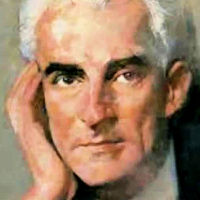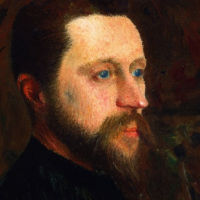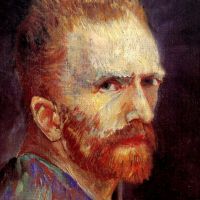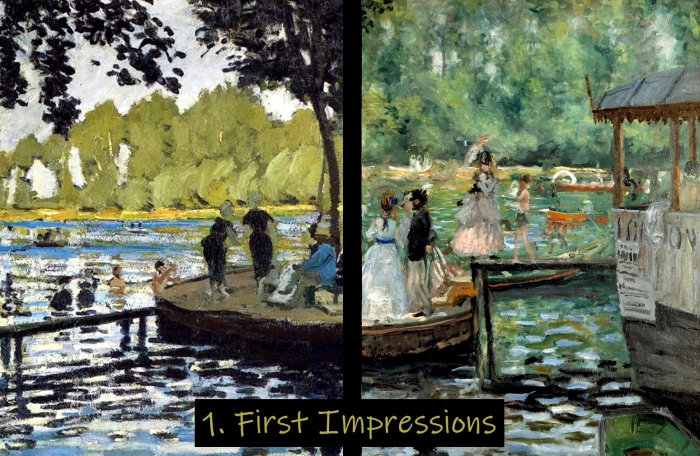ART: The slide below shows a comparison between two similar works by two of the artists to be visited in class, Gauguin and Van Gogh. We may not talk about this actual example in class, but there are lots more.



Some questions: How closely do you believe in each picture as reportage? What elements are the same in each picture? What does each have that is unique? Do both artists use the colors in the same way? Which of the two seems the warmer? What is the main focus of each artist?
MUSIC: The second hour of this class will focus on music by Maurice Ravel, for the piano, for orchestra,
and on the ballet stage. We will start by using his 1905 piano piece Alborada del Gracioso (Morning Song of the Clown) and
the hearing how how orchestrated it 15 years later. If possible, listen to the piano version in advance; I give you it both in a
live performance and audio-with-score; take your pick. I will play yet another performance in class.
Ravel: Alborada del Gracioso, played by Yundi Xu
Ravel: Alborada del Gracioso, with score, played by Jean-Yves Thibaudet
PEOPLE: Here are brief bios of the artists we shall consider in the class, plus the one composer,
listed in chronological order of birth. You can access all biographies via the BIOS link on the
syllabus page.
 |
Paul Cézanne, 1839–1906. French painter. With Gauguin and Van Gogh, though painting in a very different style from either, Cézanne is considered one of the leading artists of the Post-Impressionist period. Working first in an academic style, he was converted to Impressionism by his friend Camille Pissarro. After exhibiting in the first two group shows, however, he returned to his native Aix-en-Provence, living like a recluse and painting pictures whose play with space and surface would revolutionize 20th-century art. |
 |
Paul Gauguin, 1848–1930. French painter, sculptor, and print-maker. Influenced at first by the Impressionists, Gauguin soon abandoned that style for one that involved large flat areas of pure color. He is associated with three areas: Brittany, where he developed his style; Provence, where he lived with Van Gogh; and Tahiti, perhaps indulging a taste for the tropics inherited from his Peruvian mother. He is considered one of the giants of the Post-Impressionist period. |
 |
Maurice Ravel, 1875–1937. French composer. Though often grouped with Debussy as a musical Impressionist, Ravel was very much his own man. As a composer with a strong sense of tradition, he often wrote in older dance forms. As a virtuoso pianist, he wrote piano music of transcendent difficulty that extended the range of piano techniques. And as a master orchestrator, he enriched 20th-century music with some of its most vibrant colors. |
 |
Georges Seurat, 1859–91. French painter. Seurat exibited his masterpiece, Sunday Afternoon on the Grande Jatte, at the last Impressionst exhibition (1886), but he was never really one of their group, sketching out of doors, but preferring to work up his carefully balanced compositions in the studio. His formalization of the Impressionist technique of using contrasting colors in small brushstrokes led to the style known as pointillism or Neo-Impressionism, of which he was the founder. |
 |
Vincent van Gogh, 1853–90. Dutch Post-Impressionist painter. Beginning in his native Holland with dark paintings of peasant life, his style was transformed when he went to Paris in 1886, and thence to Arles, where he lived with Paul Gauguin. Although prolific in his output, he suffered from severe depression and eventually shot himself, while living close to his doctor in the north of France. |
ART: For the paintings discussed (or intended to be discussed) in class see below. Scroll to the end or click these links to reach the sections on MUSIC and BOOKS.
COMPARISON 1



Some questions: Compare the verticals in the two pictures. Which contains the more solid forms? Which picture seems deeper, and which more on the surface? Compare the colors: has the palette changed over 25 years, and are the hues used in the same way? Has the texture and handling of the paint changed? How do the brushstrokes contribute to the architecture of the whole?
Some facts: Cézanne had trouble finding acceptance of his earlier works, and critics did not take kindly to his contributions to the two Impressionist shows. Whether because of this rejection or his own reclusive nature, he moved back to Provence, his home turf, in 1778 and never left it, even as he achieved increasing success.
COMPARISON 2



Some questions: Are there realistic elements in either picture? If so, how are they balanced against the urge towards design? And what is the principle of such design in each? What is the relationship in each between surface and depth? How large is the palette of each artist, and how does he use it?
Some facts: Bathers at Asnières is the first of Seurat's depictions of Parisians at leisure on the banks of the Seine that would lead to his Grande Jatte of 1888. Cézanne's painting is the largest of a series of nude female bathers, and is sometimes considered his masterpiece; the others are in the principal galleries in New York, Chicago, London, Saint Petersburg, plus the Barnes Foundation also in Philadelphia.
COMPARISON 3



Some questions: Look at the activity in the paint surface of each picture; how conscious are you of the work of the brush? Does this have any relationship to the scale of the objects represented? Which building has the greatest presence? Are there any colors in any of the pictures that do not seem to come from nature? Is there any sequence to the three pictures other than their dates?
Some facts: Three different places are represented here. The 1886 mills are in Montmartre, painted in the year Van Gogh arrived in Paris, and fell immediately under the spell of the Impressionists. The 1888 one is a less well-known product of his years at Arles, in Provence; he sent it as a gift to Gauguin. The church was painted in the last months of the artist's life in Auvers, North of Paris, where Vincent had gone to be close to his doctor.
COMPARISON 4



Some questions: How closely do you believe in each picture as reportage? What elements are the same in each picture? What does each have that is unique? Do both artists use the colors in the same way? Which of the two seems the warmer? What is the main focus of each artist?
Some facts: Van Gogh described the café as "A place where one can ruin oneself, go mad, or commit a crime." He had already painted several versions on the café proprietress, Madame Ginoux, whom Gauguin depict sitting alone at one of the tables, using an almost literal repetition of Van Gogh's pose.

Van Gogh: Madame Ginoux (1888, Rome, Modern Art Museum)
COMPARISON 5



Some questions: Which painting is the more naturalistic in composition? Is the color chord the same in each? Are there examples in either picture of colors used in less natural ways? How does each artist use the falling leaves? What is the function of the figures in the Van Gogh? However you define it, which do you consider the more "colorful"?
Some facts: The Alyscamps is a large Roman necropolis, a short distance outside Arles. The name is a dialect version of Champs Elysées or Elysian Fields.
COMPARISON 6



Some questions: From what viewpoint is Gauguin painting? Is it a real one? Does Van Gogh do the same thing, or something different? If you were marketing these as a Paint-by-Numbers kit, about how many colors would you need to provide for each? Is this unusual for what you know of either artist? How does each handle the painting of the bushes? Is this carried through into the painting as a whole?
Some facts: The older woman in the Van Gogh painting is the artist's mother; he wrote to his sister that he didn't think he had done her justice. The younger woman may be the sister, or just possibly a cousin with whom Vincent fell in love.
COMPARISON 7



Some questions: Leaving aside questions of meaning for now, how does each picture work for you as an abstract composition? Which is the more natural, and which the more artificial? Which has the greater depth? What is the role of the objects in the pictures other than the women? What is the function of the third figure in the blue painting? Do the colors affect how you feel about each picture? If you did not understand the titles on the pictures themselves, what might you call each of them?
Some facts: The two titles are (in Tahitian) When Will You Marry? and (in French) Contes barbares (Barbarian Tales). Art historian Nancy Mowll Mathews wrote that Gauguin "portrayed the Tahitian natives as living only to sing and to make love," because the ideal was a better sell than the truth: "that Tahiti was an unremarkable island with an international, westernised community." The male figure is a painter friend of his, Meyer de Haan, who did not accompany Gauguin to Polynesia; his demonic aspect may hold a message about the destructive power of western civilization. [Thanks to Wikipedia for this one.]
MUSIC: Check the links below to see and hear the various Ravel pieces played in the second hour.
Stop Press: I have now added the version of Boléro danced by Maya Plisetskaya mentioned by
Marilyn in class. She is perfectly right; it is a much more subtle performance than Guillem's, less aggressive, more joyful, more
sexy even; and the men keep their shirts on! If you have 25 minutes to watch the two back to back, it makes a fascinating comparison!
Alborada del Gracioso (piano, video)
Alborada del Gracioso (piano, with score)
Alborada del Gracioso (orchestra)
Daphnis and Chloe, finale (Ashton choreography)
Daphnis and Chloe, finale (Millepied choreography)
Boléro (Sylvie Guillem, in the Béjart choreography)
Boléro (Maya Plisetskaya, see "Stop Press" above)
The script for this part of the class can be found here.
BOOKS: I'm listing two art books, neither of which I know personally. The Parsons and Gale is very large, very heavy, and very expensive, but it is well-produced and more serious than any of the others; perhaps you can find a used copy. The Chicago Art Institute symposium volume on Cézanne has yet to be published, but comes from a quality stable. There are many cheaper books such as the Taschen series of slim large-format paperbacks that have generally good texts and generous illustrations, but in a field where color is so important you need to cross-check the quality of the reproduction. The two Ravel books include the standard Cambridge handbook and a short novel about his last years that I found both enjoyable and insightful. rb.
PARSONS, Thomas and Iain Gale: Post-Impressionism: the Rise of Modern Art, 1880–1920 (NDE, 1999)
BORCHARDT-HUME, Achim, and others: Art Institute of Chicago (Art Institute of Chicago, 2022)
MAWER, Deborah. The Cambridge Companion to Ravel (Cambridge, 2000)
ECHENOZ, Jean, tr. Linda Coverdale. Ravel (Cambridge, 2000)
PEOPLE: Here are brief bios of the artists considered in the class, in order of birth.
You can access all biographies via the BIOS link on the syllabus page.
 |
Paul Cézanne, 1839–1906. French painter. With Gauguin and Van Gogh, though painting in a very different style from either, Cézanne is considered one of the leading artists of the Post-Impressionist period. Working first in an academic style, he was converted to Impressionism by his friend Camille Pissarro. After exhibiting in the first two group shows, however, he returned to his native Aix-en-Provence, living like a recluse and painting pictures whose play with space and surface would revolutionize 20th-century art. |
 |
Paul Gauguin, 1848–1930. French painter, sculptor, and print-maker. Influenced at first by the Impressionists, Gauguin soon abandoned that style for one that involved large flat areas of pure color. He is associated with three areas: Brittany, where he developed his style; Provence, where he lived with Van Gogh; and Tahiti, perhaps indulging a taste for the tropics inherited from his Peruvian mother. He is considered one of the giants of the Post-Impressionist period. |
 |
Maurice Ravel, 1875–1937. French composer. Though often grouped with Debussy as a musical Impressionist, Ravel was very much his own man. As a composer with a strong sense of tradition, he often wrote in older dance forms. As a virtuoso pianist, he wrote piano music of transcendent difficulty that extended the range of piano techniques. And as a master orchestrator, he enriched 20th-century music with some of its most vibrant colors. |
 |
Georges Seurat, 1859–91. French painter. Seurat exibited his masterpiece, Sunday Afternoon on the Grande Jatte, at the last Impressionst exhibition (1886), but he was never really one of their group, sketching out of doors, but preferring to work up his carefully balanced compositions in the studio. His formalization of the Impressionist technique of using contrasting colors in small brushstrokes led to the style known as pointillism or Neo-Impressionism, of which he was the founder. |
 |
Vincent van Gogh, 1853–90. Dutch Post-Impressionist painter. Beginning in his native Holland with dark paintings of peasant life, his style was transformed when he went to Paris in 1886, and thence to Arles, where he lived with Paul Gauguin. Although prolific in his output, he suffered from severe depression and eventually shot himself, while living close to his doctor in the north of France. |
